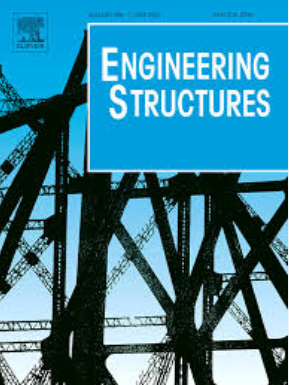Flexural fatigue strength of RC bridge girders strengthened by PHSW-PM
IF 5.6
1区 工程技术
Q1 ENGINEERING, CIVIL
引用次数: 0
Abstract
A novel method for enhancing the flexural fatigue strength of reinforced concrete (RC) bridge girders is presented. This method adopts externally attached prestressed high-strength steel wires covered by polymer mortar, referred to as PHSW-PM. To evaluate the effectiveness and applicability of this technique, monotonic and fatigue tests were conducted on RC beam specimens subjected to repeated load cycles within service load ranges. The investigation focused on four main parameters: the loading condition, the prestressing level of the high-strength steel wires, the anchorage condition, and the bond properties between the polymer mortar and the concrete surface. The RC specimens strengthened with PHSW-PM demonstrated exceptional performance under fatigue loading, withstanding over two million repeated load cycles without failure. The test results revealed that a higher level of prestressing force in the steel wires significantly enhances the crack resistance of the strengthened beams. Additionally, the bond interface condition between the polymer mortar layer and the concrete surface, along with the type of anchorage, were identified as critical factors influencing the flexural fatigue capacity and ductility of the strengthened beams. Based on the experimental results, an empirical design formula has been derived to evaluate the flexural fatigue capacity of beams strengthened using the PHSW-PM methodology. This study provides valuable insights into the potential of PHSW-PM as an effective technique for improving the structural performance of RC bridge girders under cyclic loading conditions.
PHSW-PM加固RC桥梁的弯曲疲劳强度
提出了一种提高钢筋混凝土桥梁抗弯疲劳强度的新方法。该方法采用外贴预应力高强度钢丝,外覆聚合物砂浆,简称PHSW-PM。为了评估该技术的有效性和适用性,在工作荷载范围内对RC梁试件进行了反复荷载循环的单调和疲劳试验。研究的重点是四个主要参数:加载条件、高强钢丝的预应力水平、锚固条件以及聚合物砂浆与混凝土表面的粘结性能。用PHSW-PM加固的RC试件在疲劳荷载下表现出优异的性能,承受了超过200万次的重复荷载而没有破坏。试验结果表明,预应力水平越高,加固梁的抗裂能力越强。此外,聚合物砂浆层与混凝土表面的粘结界面条件以及锚固类型是影响加固梁抗弯疲劳能力和延性的关键因素。在试验结果的基础上,推导了PHSW-PM加固梁抗弯疲劳承载力的经验设计公式。本研究为PHSW-PM作为改善循环荷载条件下RC桥梁结构性能的有效技术的潜力提供了有价值的见解。
本文章由计算机程序翻译,如有差异,请以英文原文为准。
求助全文
约1分钟内获得全文
求助全文
来源期刊

Engineering Structures
工程技术-工程:土木
CiteScore
10.20
自引率
14.50%
发文量
1385
审稿时长
67 days
期刊介绍:
Engineering Structures provides a forum for a broad blend of scientific and technical papers to reflect the evolving needs of the structural engineering and structural mechanics communities. Particularly welcome are contributions dealing with applications of structural engineering and mechanics principles in all areas of technology. The journal aspires to a broad and integrated coverage of the effects of dynamic loadings and of the modelling techniques whereby the structural response to these loadings may be computed.
The scope of Engineering Structures encompasses, but is not restricted to, the following areas: infrastructure engineering; earthquake engineering; structure-fluid-soil interaction; wind engineering; fire engineering; blast engineering; structural reliability/stability; life assessment/integrity; structural health monitoring; multi-hazard engineering; structural dynamics; optimization; expert systems; experimental modelling; performance-based design; multiscale analysis; value engineering.
Topics of interest include: tall buildings; innovative structures; environmentally responsive structures; bridges; stadiums; commercial and public buildings; transmission towers; television and telecommunication masts; foldable structures; cooling towers; plates and shells; suspension structures; protective structures; smart structures; nuclear reactors; dams; pressure vessels; pipelines; tunnels.
Engineering Structures also publishes review articles, short communications and discussions, book reviews, and a diary on international events related to any aspect of structural engineering.
 求助内容:
求助内容: 应助结果提醒方式:
应助结果提醒方式:


